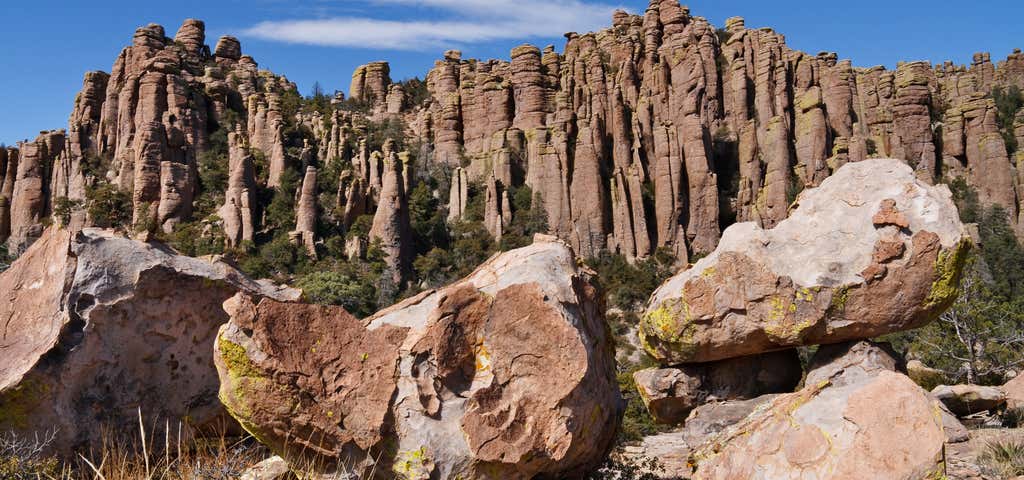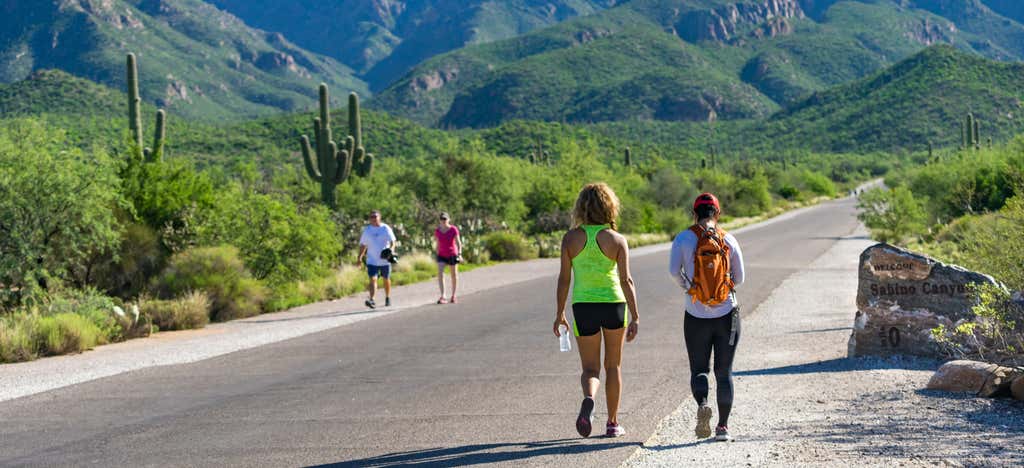Tucson has no lack of incredible desert landscapes—but people really in the know are aware of just how varied these landscapes can be. The vast desert expanse of the Sonoran Desert hides rare plant life, twisting cavern tunnels, shady wooded canyons, stone hoodoos to climb, mountains for skiing, and much more. So pack your camping gear, lace up your hiking boots or climbing shoes, fill your water bottles, and get ready to explore a desert in a class of its own.
Tucson is famous for saguaros, but a short drive from the city takes visitors to a site populated by another rare and intriguing cactus. Organ Pipe Cactus National Monument, a UNESCO biosphere reserve, is one of the only places in the country where you can find the organ pipe cactus. It's primarily wilderness, but there are plenty of trails to explore. Start at the Kris Eggle Visitor Center to watch the introductory film and check out the nature trail then set off on the Arch Canyon Trail or the Desert View Trail, both moderate hikes offering jaw-dropping views. There's also camping available; those looking for something modern will like the Twin Peaks Campground, while the Alamo Campground is more primitive. There are also zones for backcountry camping.
The most famous park in the Tucson area is, of course, Saguaro National Park, which protects the habitat of the rare saguaro cactus. The first thing to know before visiting is that the park is split into two districts. One is directly east of Tucson, the Rincon Mountain District; and the other is directly west, the Tucson Mountain District. Generally speaking, the Tucson Mountain District is more developed, and the Rincon section is more untouched wilderness. The Red Hills Visitor Center is a great starting point, and the trail behind it, the Cactus Garden Trail, is the quickest way to spy some saguaros. For a longer day hike, the 9-mile-long King Canyon Trail takes you to the highest point in the Tucson Mountains on a round trip with lots of different landscapes. You don't even have to get out of your car to take advantage of the views; the Rincon Mountain District's Cactus Forest Scenic Drive has gorgeous scenery, with plenty of pull-outs and trails along the way.
The Arizona Upland in the northern part of the Sonoran gets around 12 inches of rain a year. That's a lot of water for a desert, and it feeds Sabino Creek, creating a surprisingly green canyon filled with life. The upper canyon is only accessible by foot, bicycle, tram or tour bus, so it retains that feeling of untouched natural beauty. Park near the visitor center and then set off on one of the trails to admire waterfalls and wildlife, unlike anything you'll find elsewhere in the Sonoran. Seven Falls Trail is a popular hike that crosses back and forth over the creek. It's best seen in the spring when snowmelt kicks up the waterfalls, and early in the day, when there's plenty of shade in the canyon.
Mount Lemmon is a Tucson gem. The highest peak in the Santa Catalina Mountains, it features a winding scenic drive, the 27-mile-long Sky Island Parkway, that leads to the summit. At the top, you'll find an observatory, three campgrounds, hiking trails, rocking climbing, the country's southernmost ski area (the Mount Lemmon Ski Valley, open late December through March), and the little village of Summerhaven. A major draw of the mountain? Its elevation and cooler temperatures, are often up to 30 degrees lower than Tucson’s. And, if you like your outdoor adventure with a side of science, check out the Mt. Lemmon Science Tour app. It's a great introduction to the wonders of Arizona’s “Sky Islands” while you drive up the mountain and will give you a new appreciation for the region, which is one of the most diverse ecosystems in the world. Pro tip: grab some fudge from the Mt. Lemmon General Store for sustenance.
Nestled at the foot of the Santa Catalina Mountains and surrounded by the Coronado National Forest is Catalina State Park. It's home to thousands of majestic saguaros, along with other desert plant and animal life, all minutes outside Tucson. There are a wide variety of trails, each offering something unique and different. From quick hikes that highlight ancient ruins or birds, to longer trails for horseback riders or day hikes deep into the park's canyons, there's something for everyone, and a wide range of campsites make it a perfect escape from the city. The park is at its best in the early spring, when wildflowers carpet the desert in a riot of color.
Boasting 62 miles of trails, Tucson Mountain Park is a hiker's dream. Trails wind among huge saguaros at the base of the mountains, offering some killer Sonoran scenery. Whether you simply cruise through the park on a scenic drive, or take one of the many hikes (the one up Brown Mountain is quite popular), there's a reason this park just outside Saguaro National Park is a local favorite. It also includes shooting and archery ranges for those looking to try their hand at a new hobby.
Another unexpectedly lush area for exploring is Madera Canyon. Park in the Proctor Area and take your pick of trails, from easy-going paved nature paths to more intense trails, like the hike to the top of 9,453-foot Mt. Wrightson. When you visit, take time to explore all the different parts of the park. Creeks and streams and shade in the canyon, and cooler temps and high elevation on the mountains, sustain a massive variety of plants and animals. It's wild going from spotting prickly pear cactus in the canyon to walking among ponderosa pine, douglas fir and quaking aspen on the mountain slopes.
Like Madera Canyon and Mount Lemmon, Chiricahua National Monument is a "Sky Island," a mountain range surrounded by desert, providing incredible stargazing and a wide variety of ecosystems. In fact, this area is where the Sonoran and Chihuahuan deserts and the Rocky Mountain and Sierra Madre ranges all meet, so you can see bits and pieces unique to each here. Think ponderosa pines and oaks, cacti and ferns, rocky deserts and green woodlands--all in one place. The Chiricahua Mountains are the ancient remains of an inactive volcano range, which is how many of the monument's striking rock formations, such as its natural bridges, balanced rocks, grottoes and more, came to be. Other attractions include Bonita Canyon Scenic Drive, the historic Faraway Ranch, and outstanding stargazing at night. Whether you're just here for a day hike, or you're camping and really exploring everything to see and do here, it's a stunning park.
Tucson truly is a natural wonderland. From the ancient saguaros and unforgettable night skies to the distinctive sky islands and fascinating human and natural history all around, the landscapes of this area are simply amazing. In a lot of ways, the story of Tucson is the story of the desert, and it's one that deserves to be told.
Banner Photo Credit: Shutterstock/Patrick Poendl
Visit Tucson
Tucson (pronounced TOO-sawn) is the second-largest city in the state of Arizona, with nearly one million residents in the metro area.
Explore More Trip Guides
A Highway 1 road trip along California’s Central Coast
- 14 Places
- 02:49
- 99 mi










